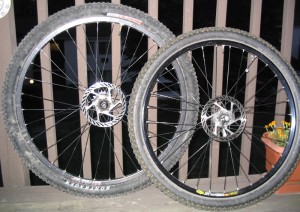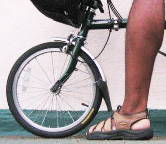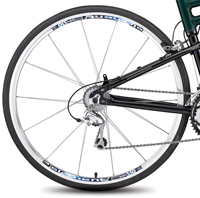Among the many choices you need to make when selecting the right bike for you, one of the more important decisions is size. This doesn’t mean just frame size, but also the size of the wheels.
You may not be familiar with the different sizes of wheels available on road bikes, mountain bikes, folding bikes, etc. – heck you might not even care. Read on to find out what sizes are available and why you should care, or at least have a cursory knowledge of bike wheel and tire sizes.
Looking at the number of different wheel sizes available from 16” in diameter all the way up to 29” (or 700C as they are referred to on road bikes) the number of choices can be overwhelming at first. Below, we break it all down for you to help make understanding wheel sizes as easy as, well, riding a bike.
One reason bike tire sizes can be confusing is they use both metric and non-metric units of measurement. For example, on mountain bikes, the largest wheel size generally available is referred to as 29”. On road bikes however, the same size wheel is referred to as 700c. Go figure.
In addition to the common names for different sizes, the exact diameter of a wheel (the metal rim) in millimeters is known as its ISO diameter. These standard sizes are defined by the International Organization for Standardization (also known as ISO).
16”, 20” and 24”
If you ride a unicycle, BMX bike or have been to the circus than you have seen what are generally considered to be the smallest wheels available on a bicycle. A number of other folding bike companies use these small wheel sizes in order to have a more compact size when folded.
While the smaller wheels produce a smaller folded package, many people find them to be less stable than their larger counterparts and they tend to provide a slightly bumpier ride on rough road surfaces. A larger gear ratio is also required when running a smaller wheel and this can lead to some difficulties when you take those little wheels up a steep hill.
These size tires generally come with treads designed for on-road or light off-road use. Some knobby tires can be found in smaller sizes for BMX and for use with children’s mountain bikes that use these smaller wheels.
26”
This is the most common size for mountain bike tires. The diameter of the rim is 22” (ISO 559) but the diameter to the outside of the tire is 26.2”. For this reason, these tires (and the wheels) are usually referred to as 26″. Tires for 26″ wheels are available in a variety of widths and treads to accommodate different width rims and riding different terrain. All of Montague’s full size folding mountain bikes use 26″ wheels.
29”
In the 1980’s bigger mountain bike wheels began to gain popularity. Often referred to as a 29er, this wheel size has the same diameter as the “700C” wheel common on many road bikes. The diameter of this rim is about 24.5” (ISO 622) and the diameter to the outside of the tire is about 28.5” (I guess 28 and a halfer doesn’t have the same ring to it!) These 29ers have seen a bit of a resurgence lately and when it comes to mountain biking, those that prefer 29” generally feel the larger tires:
- roll over obstacles more easily
- are less likely to get stuck in sand and dirt
- have better traction due to their larger contact area.
This tire is far from mainstream but has gained a strong foothold in the mountain bike world.
650C
This size is generally used by smaller riders on road bikes. The diameter of this wheel is 571mm (ISO 571) and is most common on very small road frames where the geometry cannot easily accommodate a 700C.
700C
This is the most common size of road bike wheel and has a diameter of 622mm (ISO 622). All the bikes in Montague’s pavement line use 700C wheels.
All things being equal, larger tires decrease rolling resistance. Less rolling resistance means less effort required to get you to where you want to go. Whether you are racing, touring or commuting, that’s a good thing.
What’s your preference for road, mountain bike or folding bike wheel size? (You know we prefer large wheel folders!)





What about bodysize considering this?
Do you mean height or weight?
As far as height goes, most adults can ride either 26″ or 700C wheels – some bikes designed for shorter people use the 650C size, because smaller frames can’t always accommodate 700C wheels, but other than that, the standover height of the bike is not really significantly affected by wheel choice. And if this is a concern, you could consider a step-through frame too. (But body size obviously has something to do with wheel size – this is why many children’s bikes have smaller wheels).
As far as weight goes, spoke count is more critical than the size of the wheels. If you’re heavier, your wheels will be bearing a greater load, and if they start to show signs of stress, are going out of true or out of round, it likely has less to do with the size of the wheels than the number of spokes – higher spoke count wheels are stronger, so you might consider getting a set of touring wheels/48-spoke count wheels.
You want a lower to the ground wheel, a twenty-six inch diameter wheel that comes with most off-road bikes. What about touring on back roads in a relaxed position such as a recumbent might offer. They can have wheels that are sixteen or eighteen inches in diameter.
Yes – recumbents are a totally different kettle of fish…
Guys,
Do you plan to build a 29er Montague?
Which model of Montague frame fit 29er wheel?
Regards,
Moe Emam
Question, is Montague ever coming out with a 29er / 700cc mtb? As of right now, I get a choice between a 700cc road bike and a 26er mountain. How about an all-in-one?
I am 5’3″. Which Montague Bike is best for someone my size.
Our small 16″ (mountain) or 17″ (pavement) frames would probably be best, but we don’t offer that size for every bike model. You’re right on the edge of what we normally recommend for the medium 18″/19″ frames, so you could definitely be comfortable on one of those as long as you can comfortably stand over the 29″ high top tube.
I am all confused where to buy 18″ frame for folding bike with 26″ tires. All who are selling folding bikes do not make any reference to Frame size. Is this true that if the bike does not have horizontal frame tubing that all bikes 18″ or 20″ frame should not make any difference .
Many folding bikes unfortunately are one size fits all, which ends up being a poor fit for most. However, Montague bikes are available in multiple frame sizes. If you take a look at any of our models on this site, you’ll see they are available in at least 2 sizes, 18″/19″ or 20″/21″. On some bikes we also offer a third 16″/17″ small size. The larger frames have a longer seat tube and a longer top tube to accommodate taller riders.
I am 69″ tall – what is the most compact folding bike (so I can bring it on buses and trains as luggage) that you can sell me and how much would it cost? tx – RJM anselm45@gmail.com
At 69″ (5′ 9″), our Medium frame size would be best best, which is the 18″ on mountain bikes and 19″ on pavement bikes. Choosing a model really depends on what type of riding you plan to do. Most of our pavement models are made with multi-surface riding in mind so they can certainly handle gravel and hard packed dirt. If you’re planning to take on tougher terrain with larger rocks and roots, a mountain model would be more appropriate. The folded size is very similar for all of our bikes so I’m not sure any are more compact than others. The RackStand equipped bikes are perhaps slightly taller when on the rack, but it also would make storing the bike on the train much easier. I would say the Urban and Navigator are our most versatile models so I would look at those first.
Hello, which frame size is good for me if I’m 6’1″?
Hi Alfie. At 6′ 1″, our Large frame size would be best. That’s the 20″ for mountain models and 21″ for pavement models.
Hello–I am 5’11 and a half with long legs..Since only the difference on the Highline 18″and 20″ is the a longer seat tube and a longer top tube would I be able to purchase the 18″ and adjust it for my needs or would that throw off the geometry of the bike too much.thanks
Hi Kim. We would normally recommend the large 20″ size for anyone 5’11” – 6’4″. However, if you perhaps prefer a smaller frame, you could likely ride the 18″ Highline without issue. You might find that you need a longer seatpost with that bike if you do have particularly long legs, which can be purchased aftermarket. The stock post on the 18″ frame is 300mm (30.0mm in diameter) but you have easily find 350mm or even 400mm posts.
Hello – I am 5 foot, 10.5 inches. Which frame should I choose for mountain bike? Does it make a significant difference or would both large and medium work?
At your height, we would typically recommend the Large 20″ frame for our mountain models, but you could likely be comfortable on either the Large or Medium. You’ll be able to set the saddle at the correct height for your leg length on either one, so the difference you’ll really feel is the handlebars being farther forward on the 20″ due to the longer top tube. A frame that’s too small could cause more discomfort in this case than one that’s too big, and there’s really no risk in a 20″ Large being too big for you.